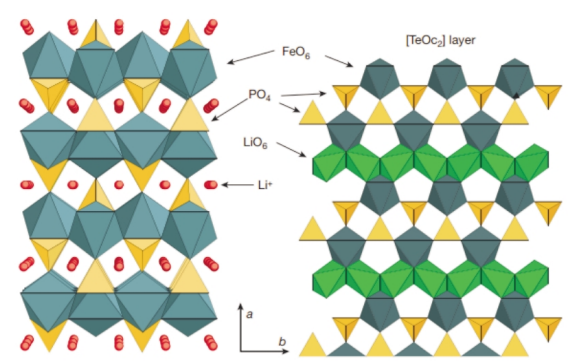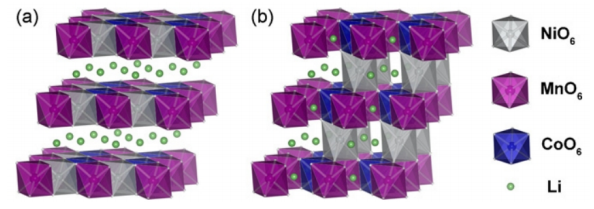In recent years, the battle between lithium iron phosphate and ternary technology routes has never stopped. In this paper, combined with the characteristics of the two cathode materials and batteries, their applications in different fields are compared and analyzed.
1. Lithium Iron Phosphate Materials and Batteries
The LiFePO4 with a three-dimensional spatial network olivine structure forms a one-dimensional Li+ transport channel, which limits the diffusion of Li+; at the same time, the octahedral FeO6 is connected at the top, making its electronic conductivity low, and the polarization is relatively high during high-rate discharge. big. In order to solve the low lithium ion diffusion and electronic conductivity of LiFePO4 materials, the current technology is mainly improved by means of nanometerization, carbon coating, and doping. The charging and discharging process of LiFePO4 material mainly transforms between LiFePO4 and FePO4 phases, and the volume change rate is small, which makes the material extremely stable, so the safety and stability of lithium iron phosphate materials and batteries are beyond doubt.

Lithium iron phosphate batteries mainly have the following characteristics:
(1) The cycle performance of lithium iron phosphate batteries is excellent, the cycle life of energy batteries can be as long as 3000 to 4000 times, and the cycles of rate batteries can even reach tens of thousands of times;
(2) The lithium iron phosphate battery has excellent safety performance, and can maintain a relatively stable structure even at high temperatures, making the lithium iron phosphate battery safe and reliable, and even when the battery is deformed and damaged, there will be no smoke, fire, etc. ACCIDENT.
On the other hand, lithium iron phosphate raw material resources are relatively abundant, which greatly reduces the cost of materials and batteries. At the same time, because iron and phosphorus elements are environmentally friendly, lithium iron phosphate materials and batteries do not pollute the environment. However, the structural properties of LiFePO4 material determine that the material has low ionic and electronic conductivity, and as the temperature decreases, both the electron transfer resistance and the charge transfer resistance increase rapidly, resulting in poor low-temperature battery performance.
2. Ternary materials and batteries
Since the Li(NixCoyMn1-x-y )O2 material was first reported, it has attracted great attention of researchers. In order to reduce the cost pressure caused by the price increase of Co, researches on ternary materials with low or even no Co have been carried out at home and abroad, and such materials may become mainstream cathode materials in the future.
Li(NixCoyMn1-x-y )O2 has structural similarities with LiCoO2. Taking the NCM111 ternary material as an example, Li+ is located at the 3a position in the structure, Ni, Mn, and Co are randomly distributed at the 3b position, and lattice oxygen occupies the 6c position. The transition metal layer structure is composed of Ni, Mn, Co, and is surrounded by 6 lattice oxygens to form a MO6 (M=Ni, Co or Mn) octahedral structure, and lithium ions are inserted between the MO6 layers. During the charging and discharging process, lithium ions are deintercalated in the interlayer structure of MO6, and the electric pairs participating in the electrochemical reaction are Ni2+/Ni3+, Ni3+/Ni4+ and Co3+/Co4+, respectively, while Mn is electrochemically inert and does not contribute to electrochemical reactions. capacity.

First of all, since the radius of Ni2+ is very close to the radius of Li+, with the increase of Ni content, the probability of Li/Ni mixing in high-nickel ternary materials increases sharply during high-temperature sintering preparation, and the lithium deintercalation into the MO6 layer is more difficult, hindering Li+ transport ability, resulting in lower specific capacity and lower cycle performance, which is difficult to reverse.
Secondly, with the increase of Ni content, the proportion of Ni3+ in the material also increases, and Ni3+ is very unstable, and it is very easy to react with moisture and CO2 in the air to form surface residual alkali when exposed to air, resulting in ternary material capacity and Cycle performance loss. In addition, too much residual alkali on the surface will cause serious gas production in the ternary battery, affecting its cycle performance and safety performance.
Third, the high-valent Ni element also has high catalytic activity and oxidizing property, which leads to the decomposition of the electrolyte and also causes gas production in the battery. In order to solve the above problems, customization of precursors, individualization of sintering process, ion doping, surface coating modification, wet processing and production environment control have become common choices for ternary material manufacturers.
For the ternary battery, its performance characteristics mainly include high material mass specific capacity, mass and volume specific energy, good rate performance and low temperature performance, but due to the stable structure and scarcity of nickel and cobalt resources, its cycle Better performance, general safety performance, and higher cost.
3. Comparative analysis of two materials and batteries
3.1 Energy density
Compared with lithium iron phosphate materials, ternary materials have higher discharge specific capacity and higher average voltage, so the mass specific energy of ternary batteries is generally higher than that of lithium iron phosphate. In addition, due to the low true density, small particle size and carbon coating of the lithium iron phosphate material, the compacted density of the pole piece is about 2.3-2.4 g/cm3, while the compacted density of the ternary pole piece can reach 3.3 ~3.5 g/cm3, so the volume specific energy of ternary materials and batteries is also much higher than that of lithium iron phosphate.
3.2 Security
From the point of view of safety, the main structure of the lithium iron phosphate material is PO4, and its bond energy is much higher than the M-O bond energy of the ternary material MO6 octahedron. The thermal decomposition temperature of the fully charged lithium iron phosphate material is about 700 ℃. The thermal decomposition temperature of the corresponding ternary material is 200-300 °C, so the lithium iron phosphate material is safer. From a battery perspective, lithium iron phosphate batteries can pass all safety tests, while ternary batteries cannot easily pass tests such as acupuncture and overcharge, and need to be improved from structural parts and battery design.
3.3 Power performance
The activation energy of Li+ of the lithium iron phosphate material is only 0.3-0.5 eV, resulting in a Li+ diffusion coefficient of the order of 10-15-10-12 cm2/s. The extremely low electronic conductivity and lithium-ion diffusion coefficient lead to poor LFP power performance. The Li+ diffusion coefficient of the ternary material is about 10-12 ~ 10-10 cm2/s, and the electronic conductivity is high, so the ternary battery has better power performance.
3.4 Temperature suitability
Affected by the low electronic conductivity and ionic conductivity of the lithium iron phosphate material, the low temperature performance of the lithium iron phosphate battery is poor. Compared with normal temperature, the capacity retention rate of lithium iron phosphate battery discharge at -20 ℃ is only about 60%, while the ternary battery of the same system can reach more than 70%.
3.5 Cost and Environmental Factors
Ternary materials contain rare metals such as Ni and Co, and their cost is higher than that of lithium iron phosphate. With the improvement of materials and battery technology, the cost of ternary and lithium iron phosphate batteries has dropped significantly. At present, the market price of ternary batteries is higher than that of lithium iron phosphate batteries. At the same time, compared with the environmentally friendly Fe and P elements, the Ni and Co elements in the ternary materials and batteries are more polluting to the environment. Combined with the above factors, the demand for environmental control and waste recycling of ternary materials and batteries is more urgent.

